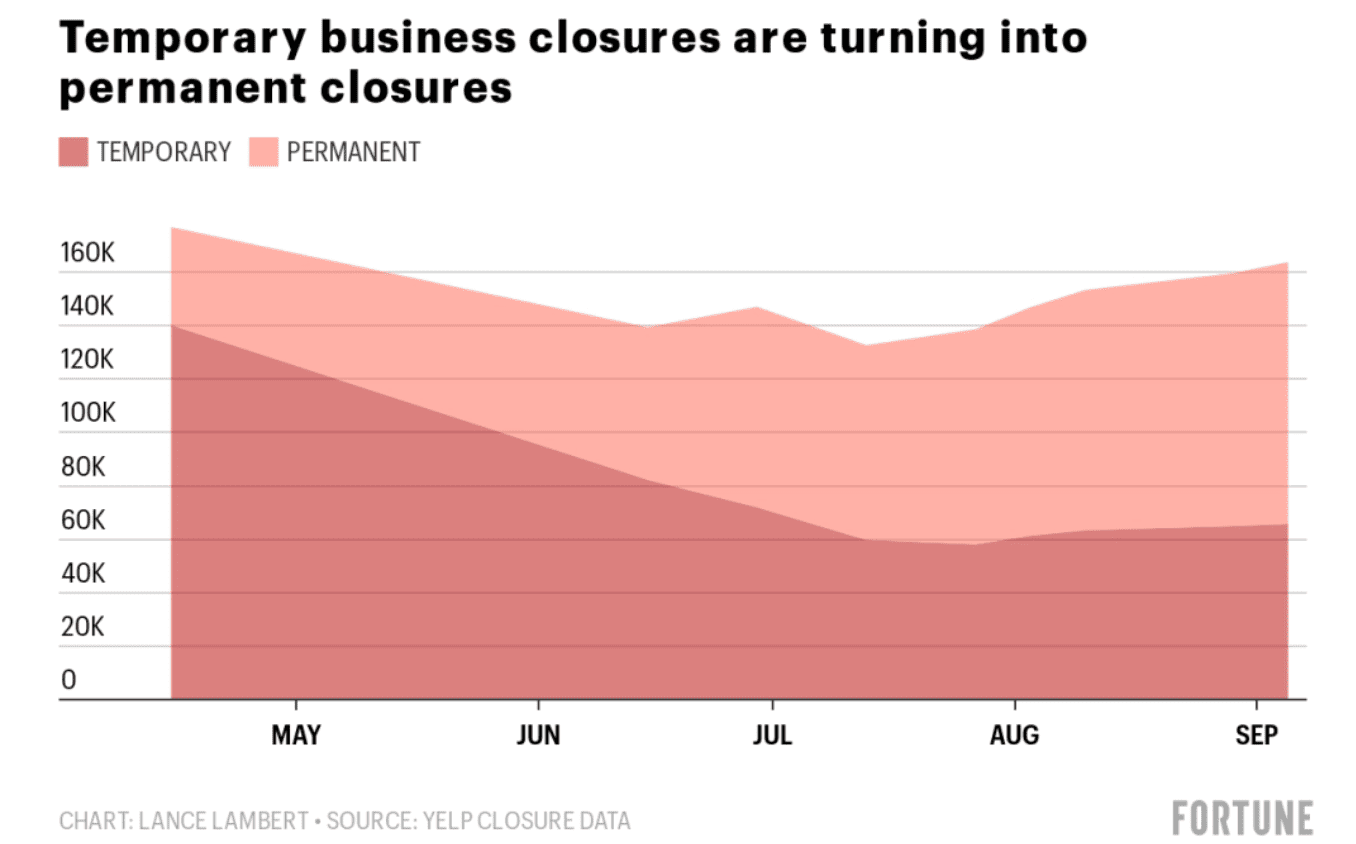Here at Celayix, a significant amount of our business comes from markets and industries that are either growing rapidly or have completely stopped due to the pandemic. There don’t seem to be many organizations that have experienced the middle of these two extremes. It’s one or the other.
We’ve also observed one of three responses:
- Wait for the pandemic to pass,
- Restructure costs to survive in the same markets,
- Or “pivot” to a better market opportunity.
Tragically, for some, their reactions to adapting to survival have been too late. In the case of many small businesses, their available cash on hand was inadequate to sustain temporary closure[1]. As of September 2020, nearly 100,000 U.S. businesses have closed permanently, with another 60,000 temporarily closed[2].

.
There seems to have been a point around six months from the beginning of the pandemic[3], where the number of temporary closures leveled off. However, permanent closures continued to increase. This suggests that companies are not seeing a turn-around for their businesses in the short-term.
With the recent news of pharma companies like Pfizer ready for FDA emergency approval[4], there is a lot of discussion about the timeline for a return to normal. Is an end in sight?
One recent comment from one of the logistics companies that pharma companies depend on for shipping the vaccine, DHL, say they are planning for a two-year process[5]. This suggests that the logistics of distributing a vaccine may delay our return to “normal”. As responsible business leaders, we need a Plan B in case Plan “V” is delayed.
Survival and Thrival Strategies
All companies have limited resources – time, people, cash, knowledge – to name a few. Strategy is about making decisions between two or more mutually exclusive options in order to get a significant and improved outcome.
Early on in the pandemic, Celayix made the decision to focus on growth markets. Also, we put financial support policies in place to support its customers in markets that shut down. We were fortunate that demand for improved employee shift-scheduling in two of our key markets, Security Services, and Healthcare. In fact, it skyrocketed, which enables us to provide support programs to those who are not.
Adapting for Survival
In the Events and Venues market, we saw most of our customers shut down completely. Some of the professional sports teams that work with us still have televised revenues, adapting their business to a virtual crowd reality. However, the demand for venue staff has significantly diminished. Most events are cancelled, with some operating physically distanced with masked alternatives to create some cash flow. For the Hospitality industry, some of our larger customers have begun to re-open with similar distancing and protective measures in place but with reduced capacity.
Adapting for the survival of current circumstances will buy them time until the logistics of vaccine distribution can be materially complete. However, the risk is that cash flow may not last long enough to reach a time where full reopening is possible. In some cases, the risk is on dependence on government support programs and bank programs to defer major debt payments.
Pivoting for Thrival
In the Security Guard & Patrol Services market, companies that were focused on Event Security saw their business disappear. Whereas, those that focused on Site Security grew rapidly – in many cases 50% – 200%. This saw some of our Event Security customers pivot their business to take advantage of growth in commercial site security, covering businesses that temporarily shut down. For example, retail stores such as grocery use Security to manage their compliance with mask and hygiene policies.
Another example is the restaurant sector. Adapting for survival, some restaurant chains started using delivery services like DoorDash. On the other hand, others have pivoted to “thrival” by moving to their own in-house delivery app, recapturing the profit taken by third-party delivery services.
The silver lining for “thrival” firms is that they still have the knowledge and systems to take advantage of a return to normal, while taking advantage of growth opportunities in similar markets.
What Can You Do?
One of the best things a business can do in this environment is to “re-frame” the problems presented by the pandemic as opportunities:
- Adapt to survive.
Restructure your costs and suspend unprofitable activities. Make sure you can buy yourself enough time to pivot your business to growth opportunities.
(Note: companies that continue to invest in their sales and marketing efforts historically survive and outperform competitors who choose to make cuts in those areas during an economic downturn[6].) - Seize the opportunity to re-assess your current market strategy.
Look either for markets that are growing in the current circumstances, or at least not declining. - Identify other problems your business’ resources can solve in your current markets.
Are there other problems your current customers are experiencing that you have the resources to address? - Identify adjacent markets.
Is there a market with similar problems you can inexpensively pivot to and use your firm’s capabilities and experience to pursue? - Redirect your limited resources to areas with growth.
Come back to non-growth markets later. - Take this time to improve your processes and upgrade assets & equipment.
Improve your competitive advantage – that’s what your competitors will be doing.
The one thing you can’t afford to do is wait. The way our businesses operated before the pandemic is not the way they are operating now. See the silver lining in the current situation as an opportunity for renewing your next stage of growth.
References
- [1] “The impact of COVID-19 on small business outcomes and expectations”, PNAS, July 28, 2020
- [2] “Nearly 100,000 establishments that temporarily shut down due to the pandemic are now out of business”, Fortune, September 28, 2020
- [3] “A Timeline of COVID-19 Developments in 2020”, AJMC, July 3 2020
- [4] “Our COVID-19 Vaccine Shttps://www.pfizer.com/news/articles/what_to_know_about_coronavirus_covid_19_explainedtudy – What’s Next?”, Pfizer, November 18, 2020
- [5] “Special delivery: the logistics of curing Covid-19”, Pharma Technology Focus, November 2020
- [6] “Roaring Out of Recession”, Harvard Business Review, March 2010




